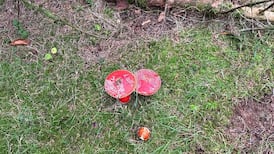An annual spring communion with the polytunnel's visiting bumblebees found me in a bright-blue T-shirt, the tunnel's rising warmth having stripped me of anorak and jumper. The big fluffy queens of Bombus terrestris paused from cutting holes in the backs of broad-bean flowers, the better to suck out their nectar, and came over to buzz me closely, circling like biplanes on reconnaissance in the first World War.
The attraction was my T-shirt’s colour, this confirmed by the bees’ exploration of the even more vivid blue of the label on a bucket of chicken manure. A bit of purple, I am told scientifically, might have offered even more promise. This streaks the bold black-and-white blossoms of the beans, and our bed of purple cranesbill geraniums will soon be thronged with bees for weeks.
How odd, then, that bright yellow is the colour of the first spring wild flowers: celandines, primroses, dandelions. Dandelions, above all, their florets oozing nectar, set the beeline for Bombus when she emerges, hungry for breakfast, from winter hibernation.
Another study, from Cambridge University, decided that flowers with colours standing out boldly from their background are the most important to foraging bumblebees, and dandelions certainly fit that bill. Conquering prejudice, I now welcome their golden glow, so early in a chilly March.
That’s certainly the choice of the important All-Ireland Pollinator Plan 2015-2020, now supported by some 20 government agencies and NGOs, north and south. Allowing dandelions to grow around the farm is just one proposal in a document abounding in practical targets. These borrow international initiatives, as the human world faces up to the crisis of losing much of the abundant choice on supermarket food shelves. (Some 4,000 of Europe’s vegetable varieties exist thanks to pollination by bees.)
Among the plan’s model examples, all backed by scientific trials, are planting road verges with native grasses and flowers (as in the US), bringing reed-stem nest boxes into farmland (as in Germany), and bringing solitary bees into urban gardens with artificial nests of bamboo or drilled wood (as in the UK). The list goes on, through the need to save or create wild-flower meadows, flowering hedgerows and field margins, and more bee-friendly strips between fields of crops and prairies of flowerless grass.
The decline of honeybees in Ireland has been largely caused by the presence of the varroa parasite on imported queens, so the losses among the principal wild pollinators are even more troubling. A third of our 20 kinds of bumblebee are threatened with extinction, plus a similar share of our 76 species of solitary bee and about a fifth of our 180 hoverfly species. For the past 20 years Ireland's commercial polytunnel growers of around-the-year strawberries have been importing colonies of Bombus terrestris from Europe, bringing with them the risk of introducing new disease if they escape.
Mine, of course, flew in the tunnel door from the Wild Atlantic Way with a resonant Thallabawn buzz. They are also remote from pesticides, in particular the neonicotinoids, in widespread use to control aphids on vegetable crops and beetles on rapeseed. Ireland abstained from the EU vote in 2013 banning three of the “neonics”, citing lack of Irish field research on their impacts.
The ban has yet to be made permanent, but the latest negative finding internationally, from two Scottish universities, shows that even low levels of neonicotinoids impair bee brain cells and cut numbers by half in bumblebee colonies. The new pollinator plan acknowledges the lack of Irish field research but notes an unsurprising finding by Trinity College Dublin in 2011 that Irish organic dairy farms have higher numbers of both flowers and insects.
The plan was developed by an impressively broad steering group, drawn from government agricultural departments north and south, Teagasc, environmental agencies, the National Roads Authority, schools and gardening groups, Tidy Towns, beekeepers and more – everyone, it seems, except the farming organisations, surely "key stakeholders" in such a "shared plan of action". Perhaps they will have offered some commitment before final publication, later this summer.
Meanwhile, a model of community action is offered by a group in Limerick who have enriched a derelict stretch of the city centre with a bee-friendly garden in which to sit. They have also used it for a wild-bee exhibition and workshops, and have had the National Biodiversity Centre train a score of bumblebee surveyors to monitor species and numbers across the county. (Go to limericksbuzzing.ie.)
“Homelessness”, as the pollinator plan puts it, is the number one threat to bees, as the intensification of farming wipes out their natural habitats. But hunger comes next, as towns and gardens are emptied of the wild flowers we call weeds. Let’s leave more dandelions in the cracks, for a start.










